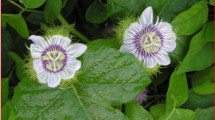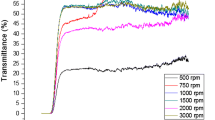Abstract
A proven photocatalyst, titanium dioxide in the form of nano-anatase, is capable of undergoing electron transfer reactions under light. In previous studies, we had proven that nano-anatase could absorb ultraviolet light (UV-B) and convert light energy to stable chemistry energy finally via electron transport in spinach chloroplasts.The mechanisms by which nano-anatase promotes antioxidant stress in spinach chloroplasts under UV-B radiation are still not clearly understood. In the present paper, we investigate the effects of nano-anatase on the antioxidant stress in spinach chloroplasts under UV-B radiation. The results showed that nano-anatase treatment could significantly decrease accumulation of superoxide radicals\({\left( {{\text{O}}^{{ \cdot - }}_{2} } \right)}\), hydrogen peoxide (H2O2), and malonyldialdehyde (MDA) content, and increase activities of superoxide dismutase (SOD), catalase (CAT), ascorbate peroxidase (APX), guaiacol peroxidase (GPX), and elevate evolution oxygen rate in spinach chloroplasts under UV-B radiation. Together, nano-anatase could decrease the oxidative stress to spinach chloroplast caused by UV-B radiation.








Similar content being viewed by others
References
Irina M, Yakovleva A, Titlyanov E (2001) Effect of high visible and UV irradiance on subtidal chondrus crispus: stress, photoinhibition and protective mechanisms. Aquat Bot 71:47–61
Figueroa FL, Nygard C, Ekelund N, Gomez I (2003) Photobiological characteristics and photosynthetic UV responses in two Ulva species (Chlorophyta) from southern Spain. J Photochem Photobiol B Biol 72:35–44
Hernando MP, Ferreyra GA (2005) The effects of UV radiation on photosynthesis in an Antarctic diatom (Thalassiosira sp.): does vertical mixing matter? J Exp Mar Biol Ecol 325:35–45
Correia CM, Torres-Pereira JMG, Pereira JMM, Björn LO, Coutinho JF (2005) Ultraviolet-B radiation and nitrogen affect the photosynthesis of maize: a Mediterranean field study. Eur J Agronomy 22:337–347
Yue XG, Han F, Shi SB, Li HM (2005) Effects of UV-B radiation of different intensity on the photosynthesis and the dark respiration of alpine plant Gentiana straminea. Acta Bot Boreal-Occident Sin 25(2):231–235
Chen YY, Xu XL, Shen XY, Zhang ZG (2005) Advances of research on effects of enhanced UV-B on algae. Jiangxi Sci 2(23):180–184
Cai HJ, Tang XX, Zhang PY, Yang Z (2005) Effects of UV-B radiation on the growth, physiological and biochemical characteristics of Ulva pertusa Kjellman. Sci Technol Eng 5(5):1671–1815
Keiler DR, Mackerness SAH, Holmes MG (2003) The action of a range of supplementary ultraviolet (UV) wavelengths on photosynthesis in Brassicanapus L. in the natural environment: effects on PS II, CO2 assimilation and level of chloroplast proteins. Photosynth Res 75:139–150
Choi BY, Roh KS (2003) UV-B radiation affects chlorophyll and activation of rubisco by rubisco activase in Canavalia ensiformis L. leaves. J Plant Biol 46:117–121
Strid A Porra RJ (1992) Alterations in pigment content in leaves of Pisum sativum after exposure to supplementary UV-B. Plant Cell Physiol 33:1015–1023
Jansen MAK (2002) Ultraviolet-B radiation effects on plants: Induction of morphogenic responses. Physiol Plant 116:423–429
Eva H (ed) (1999) Utilizing new adamantly spin traps in studying UV-B-induced oxidative damage of photosystem II. J Photochem Photobiol B Biol 48:174–179
Crabtree RH (1998) A new type of hydrogen bond. Science 282:2000–2001
Zheng L, Hong FS, Lv SP et al (2005) Effect of nano-TiO2 on strength of naturally aged seeds and growth of spinach. Biol Trace Elem Res 104(1):82–93
Hong FS, Yang P, Gao FQ et al (2005) Effect of nano-TiO2 on spectral characterization of photosystem. II particles from spinach. Chem Res Chin Univ 21(2):196–200
Hong FS, Zhou J, Liu C et al (2005) Effect of nano-TiO2 on photochemical reaction of chloroplasts of spinach. Biol Trace Elem Res 105(3):269–280
Gao FQ, Hong FS, Liu C, Zheng L, Su MY, Wu X, Yang F, Wu C, Yang P (2006) Mechanism of nano-anatase TiO2 on promoting photosynthetic carbon reaction of spinach: inducing complex of Rubisco-Rubisco activase. Biol Trace Elem Res 11(1–3):239–254
Hong FS, Yang F, Ma ZN et al (2005) Influences of nano-TiO2 on the chloroplast ageing of spinach under light. Biol Trace Element Res 104(3):249–260
Zheng L, Su MY, Liu C, Chen L, Huang H, Wu X, Liu XQ, Yang F, Gao FQ, Hong FS (2007) Effects of nano-anatase TiO2 on photosynthesis of spinach chloroplasts under different light illumination. Biol Trace Elem Res. DOI 10.1007/s12011-007-0047-3 (Online)
Su MY, Hong F, Liu C, Wu X, Liu XQ, Cheng L, Gao FQ, Yang F, Li ZR (2007) Effects of nano-anatase TiO2 on absorption, distribution of light and photochemical activities of chloroplast of spinach. Biol Trace Elem Res. DOI 10.1007/s12011-007-0006-2 (Online)
Su MY, Wu X, Liu C, Qu CX, Liu XQ, Cheng L, Huang H, Hong FS (2007) Promotion of energy transfer and oxygen evolution in spinach photosystem II by nano-anatase TiO2. Biol Trace Elem Res. DOI 10.1007/s12011-007-0065-1 (Online)
Yang P, Lu C, Hua N, Du Y (2002) Titanim dioxide nanoparticles co-doped with Fe3+ and Eu3+ ions for photocatalysis. Mater Lett 57:794–801
Able AJ, Guest DI, Sutherland MW (1998) Use of a new tetrazolium-based assay to study the prodution of superoxide radicals by tobacco cell cultures challenged with avirulent zoopspores of Phytophthora parasitca var nicotianae. Plant Physiol 117:491–499
Wang AG, Luo GH (1990) Relationship between superoxide free radicals of plant and hydroxyl-ammonia quantitative reaction. Plant Physiol Commun 26(6):55–59 (in Chinese)
Heath RL, Packer L (1968) Photoperoxidation in isolated chloroplasts: I. Kinetics and stoichiometry of fatty acid peroxidation. Arch Biochem Biophys 125:189–198
Ginnopolitis CN, Rice SK (1977) Superoxide dismutase purification and quantitative relationship with water soluble protein in seedling. Plant Physiol 59:315–318
Prasad TK (1997) Role of catalase in inducing chilling tolerance in pre-emergent maize seedlings. Plant Physiol 114:1369–1376
Reuveni R, Karchi Z, Kuc J (1992) Peroxidase activity as a biochemical marker for resistance of muskmelon (Cucumis melo) to seudoperno spora cubensis. Phytopathology 82:749–753
Lu CM, Fan GX, Wu GR (1999) Effect of Hg and Cd on chlorophyll content and scavenging system of activated oxygen in winter bud of spinach. J Lake Sci 4:322–327
Gu GP, Zhou CF, Wu GR, Lu CM (2001) The physiological adaptation of Platanus acerifolia bud in winter. Acta Botanica Boreali-Occidentalia Sinica 21(4):650–655
Crstina LM, Pinzino SC, Navari-izzo F (1996) Sunflower seedlings subjected to increasing stress by water deficit, Change in O2 production related to the composition of thylakoid membranes. Physiol Plant 96:446–452
Wang BS (1988) Biological free radicals and membrane damage of plants. Plant Physiol Commun 2:12–16 (in Chinese)
Price AH, Hendry GAF (1989) Drought-induced oxidative stress in wheat. Biochem Soc Tran 17:493–494
Huang SB, Liu XZ, Dai QJ, Wang ZX (1998) Effect of ultraviolet-B irradiation on lipid peroxidation in spinach leaves. Acta Botanica Sinic 40:542–547
John G, Scandalios JG (1993) Oxygen stress and superoxide dismutase. Plant Physiol 101:7–12
Lu CM, Zhang CY, Wen JQ, Wu GR (2002) Effects of nano material on germination and growth of soybean. Soybean Sci 21(3):168–171 (in Chinese)
Acknowledgements
This work was supported by the National Natural Science Foundation of China (grant no. 20671067, 30470150) and by the Jiangsu Province Universities Natural Science Foundation (grant no. 06KJB180094).
Author information
Authors and Affiliations
Corresponding author
Rights and permissions
About this article
Cite this article
Lei, Z., Mingyu, S., Xiao, W. et al. Antioxidant Stress is Promoted by Nano-anatase in Spinach Chloroplasts Under UV-B Radiation. Biol Trace Elem Res 121, 69–79 (2008). https://doi.org/10.1007/s12011-007-8028-0
Received:
Accepted:
Published:
Issue Date:
DOI: https://doi.org/10.1007/s12011-007-8028-0




